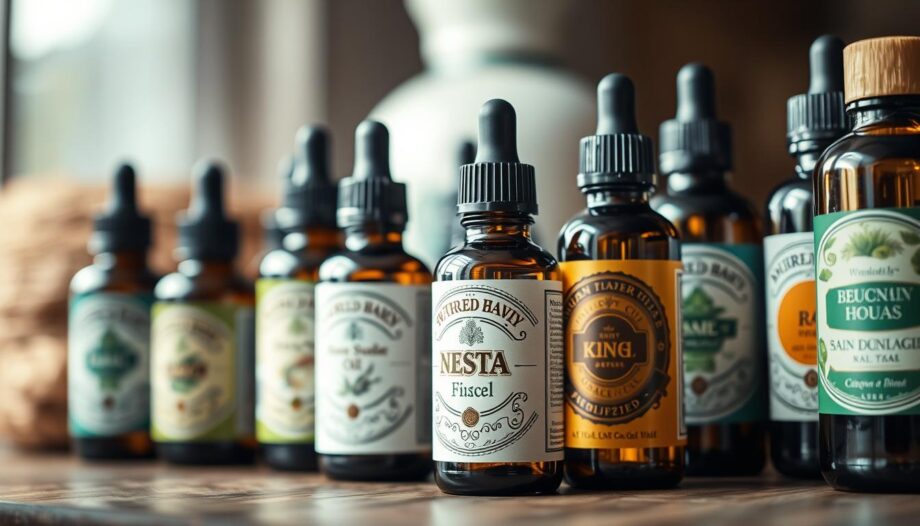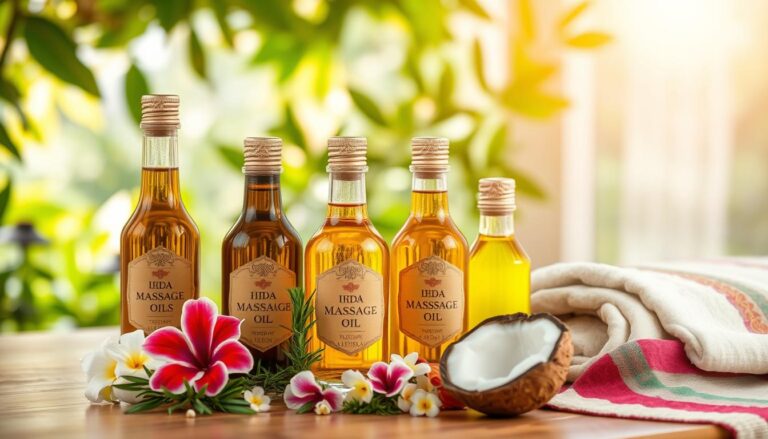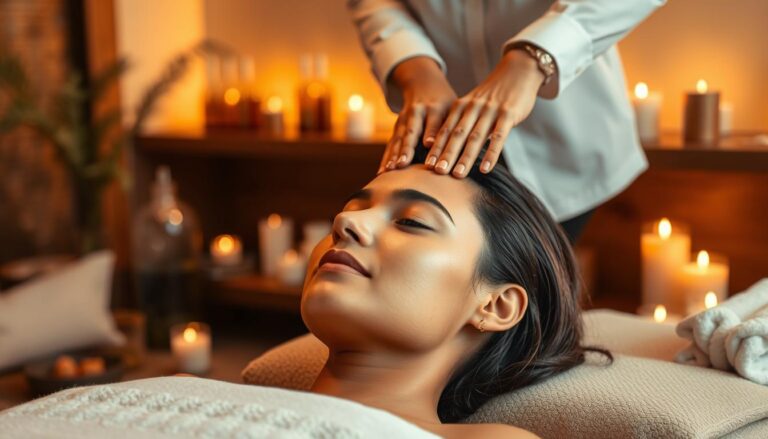Indian head massage is a 5000-year-old Ayurvedic practice deeply rooted in cultural traditions. This ancient technique focuses on physical health, emotional balance, and spiritual well-being. It targets key acupressure points on the head, neck, shoulders, and face, offering a holistic approach to relaxation and rejuvenation.
In modern times, this practice has gained popularity in the UK for its ability to relieve stress and improve hair and scalp health. Many people now incorporate it into their self-care routines to combat the pressures of daily life. The use of specific oils enhances the experience, providing additional nourishment and therapeutic effects.
This article explores the top oils used in this practice, including coconut, almond, sesame, amla, and jojoba. Each of these oils offers unique benefits, from moisturising the scalp to promoting relaxation. Whether you’re new to this technique or a seasoned practitioner, understanding the role of these oils can elevate your experience.
We’ll delve into both traditional uses and modern adaptations, helping you make the most of this ancient practice in today’s fast-paced world. For more detailed techniques, check out our guide on essential techniques for a perfect Indian head.
Key Takeaways
- Indian head massage is an ancient Ayurvedic practice with a 5000-year history.
- It focuses on physical health, emotional balance, and spiritual well-being.
- Modern applications include stress relief and hair/scalp care.
- Popular oils used are coconut, almond, sesame, amla, and jojoba.
- Each oil offers unique benefits, from moisturising to relaxation.
- Traditional and modern adaptations are explored in this article.
Introduction to Indian Head Massage
Rooted in ancient Ayurvedic traditions, the practice of Indian head massage has been passed down through generations. Known as ‘Champi,’ this technique is deeply embedded in Indian culture, offering both physical and emotional benefits. It’s a time-honoured ritual that continues to thrive in modern times.
A typical session lasts between 20 to 45 minutes, blending massage with storytelling. This combination creates a soothing experience that nurtures the mind and body. Families often use this practice to bond, making it a cherished part of daily life.
In India, this practice holds cultural significance, especially during weddings and family gatherings. It’s not uncommon to see multiple generations, from babies to the elderly, enjoying its benefits. Kerala families, for instance, often use coconut oil, while northern regions prefer mustard oil.
Christy Mathew, a practitioner in the UK, shares how her multi-generational family maintains these traditions.
“Adapting these practices in the UK has been a beautiful way to stay connected to our roots,”
she says. Her story highlights the enduring relevance of this ancient technique in today’s fast-paced world.
Across India, regional variations add unique flavours to the practice. Whether it’s the choice of oil or the techniques used, each region brings its own touch. This diversity enriches the experience, making it a truly holistic practice.
The Role of Essential Oils in Indian Head Massage
The use of oils plays a pivotal role in maximising the benefits of this traditional technique. They not only enhance the massage experience but also provide deep nourishment and therapeutic effects. Let’s explore how these oils contribute to hair health, improved circulation, and relaxation.
Deep Nourishment for Hair and Scalp
Oils like coconut and sesame are rich in nutrients that penetrate the hair cuticles, delivering moisture and strength. Coconut oil contains lauric acid, which binds to hair proteins, preventing breakage and split ends. Sesame oil, on the other hand, is packed with antioxidants that combat premature greying and improve scalp health.
Warm oils are particularly effective as they open up the hair follicles, allowing nutrients to reach the roots. This process ensures that your hair and scalp receive the nourishment they need to stay healthy and vibrant.
Improved Blood Circulation
Massaging the scalp with oils stimulates blood flow, increasing oxygen supply to the hair follicles by up to 31%. This enhanced circulation promotes healthier hair growth and strengthens the roots. Focus on pressure points around the temples and neck to maximise the benefits.
Stress Reduction and Relaxation
Certain oils, like lavender, have aromatic properties that impact the limbic system, lowering heart rate and reducing stress. A study showed a 22% reduction in stress levels among participants who used these oils during massage. The soothing scent also triggers the release of serotonin and dopamine, promoting a sense of calm and well-being.
By incorporating these oils into your routine, you can alleviate tension and enjoy a deeply relaxing experience. Whether you’re looking to improve hair health or unwind after a long day, these oils offer a holistic solution.
Top Essential Oils for Indian Head Massage
Choosing the right oil can significantly enhance the effectiveness of your scalp and hair care routine. Each oil offers unique benefits, from moisturising the scalp to promoting hair growth. Let’s explore the top options and how they can benefit you.
Coconut Oil
Coconut oil is a popular choice for its deep moisturising properties. It penetrates the hair cuticles, strengthening them and preventing breakage. This oil is suitable for all hair types and leaves a pleasant, natural fragrance.
Almond Oil
Rich in vitamins E and D, almond oil is ideal for promoting shine and moisture. It’s particularly effective for those looking to enhance hair growth and reduce dryness. Its lightweight texture makes it easy to absorb without leaving a greasy residue.
Sesame Oil
Cold-pressed sesame oil retains 97% of its nutrients, making it a powerhouse for scalp nourishment. It has a warming effect, which helps ease tension and promotes relaxation. This oil is perfect for dry scalps needing deep hydration.
Amla Oil
Known for its high vitamin C content, amla oil strengthens hair and stimulates follicles. It’s particularly beneficial for those experiencing hair fall or thinning. Regular use can lead to thicker, healthier hair.
Jojoba Oil
Jojoba oil mimics the scalp’s natural sebum, balancing oil production without causing greasiness. It’s an excellent choice for oily scalps, providing moisture without clogging pores. This oil also promotes a healthy scalp environment.
| Oil | Best For | Key Benefit |
|---|---|---|
| Coconut Oil | All Hair Types | Deep Moisturisation |
| Almond Oil | Dry Hair | Promotes Shine |
| Sesame Oil | Dry Scalp | Deep Hydration |
| Amla Oil | Thinning Hair | Strengthens Follicles |
| Jojoba Oil | Oily Scalp | Balances Oil Production |
For those looking to create custom blends, mixing oils like coconut and almond in a 1:1 ratio can enhance their benefits. Always opt for cold-pressed, unrefined oils to ensure maximum nutrient retention. Be cautious of adulterated commercial products, as they may lack the therapeutic properties of pure oils.
“Using a blend of 10 different oils, my daughter saw a noticeable increase in hair thickness and health,” shares Christy Mathew, a practitioner in the UK.
For more insights on selecting the right oil for your needs, check out our guide on best oils for scalp and hair.
Benefits of Using Essential Oils in Indian Head Massage
Incorporating specific oils into your routine can transform the way you care for your scalp and overall well-being. These oils offer a range of benefits, from promoting hair growth to enhancing mental clarity. Let’s explore how they can improve your health and daily life.
Promoting Hair Growth
Stimulating hair follicles is one of the key benefits of using these oils. Increased blood flow to the scalp ensures that nutrients reach the roots, encouraging healthier and stronger hair. For example, a blend of coconut and almond oil has been shown to improve hair thickness over time.
Regular massage with warm oils can also reduce hair fall. This practice not only strengthens the hair scalp but also creates a relaxing experience. Many users report noticeable improvements within weeks of consistent use.
Reducing Scalp Conditions
Certain oils are highly effective in addressing common scalp issues. Neem oil, for instance, eliminates 99% of scalp bacteria, making it ideal for those with dandruff or infections. A study found that 78% of users experienced reduced dandruff within four weeks of using neem-based products.
Other oils, like tea tree and rosemary, have antibacterial and antifungal properties. These can help maintain a healthy body by preventing scalp conditions from worsening. Always choose cold-pressed, unrefined oils for maximum effectiveness.
Enhancing Mental Clarity
The aromatic properties of oils like Brahmi can significantly improve focus and mental clarity. Students preparing for exams often use Brahmi oil to enhance concentration and reduce stress. Its calming effects on the mind make it a popular choice for those with busy lifestyles.
According to the NHS, incorporating relaxation techniques into your routine can lower stress levels. Using oils during scalp massage not only nourishes the hair scalp but also promotes a sense of calm and well-being. This dual benefit makes it a valuable addition to any self-care regimen.
“Regular use of Brahmi oil helped me stay focused during my studies. It’s a game-changer for anyone dealing with work-from-home tension,” shares a university student.
By understanding the benefits of these oils, you can make informed choices for your health and well-being. Whether you’re looking to improve hair growth, reduce scalp conditions, or enhance mental clarity, the right oil can make all the difference.
How to Choose the Right Oil for Your Needs
Selecting the right oil for your scalp and hair type can make a significant difference in your care routine. With so many different oils available, it’s important to understand which one suits your specific condition. Whether you’re dealing with dryness, oiliness, or hair fall, the right choice can enhance your results.
For Dry Hair and Scalp
If your hair feels brittle or your scalp is flaky, oils like almond and jojoba are excellent choices. Almond oil increases elasticity by 40%, making it ideal for restoring moisture. Jojoba oil, on the other hand, balances sebum production within 48 hours, ensuring your scalp stays hydrated without becoming greasy.
For best results, warm the oil slightly before application. This helps it penetrate deeper, providing long-lasting nourishment. Avoid coconut oil if you have low-porosity hair, as it can sit on the surface and cause buildup.
For Oily Hair and Scalp
Oily scalps require lightweight oils that won’t clog pores. Jojoba oil is a top pick as it mimics the scalp’s natural sebum, regulating oil production. Pumpkin seed oil is another great option, as it blocks DHT hormones, which can contribute to excess oiliness.
When using these oils, apply sparingly and focus on the scalp rather than the lengths of your hair. This ensures your roots stay balanced without weighing down your strands.
For Hair Fall and Thinning
If you’re experiencing hair fall, oils like amla and pumpkin seed can help strengthen your follicles. Amla oil is rich in vitamin C, which promotes thicker, healthier growth. Pumpkin seed oil, as mentioned, blocks DHT hormones, a common cause of thinning.
Combine these oils with a gentle scalp massage to stimulate blood flow. This not only reduces hair fall but also promotes relaxation, making it a win-win for your skin and overall well-being.
Before using any oil, perform a patch test to ensure it suits your condition. Additionally, consider seasonal adjustments—opt for heavier blends in winter and lighter ones in summer. By tailoring your choice to your needs, you can make the most of these different oils and enjoy healthier, more vibrant hair.
How to Use Essential Oils in Indian Head Massage
Mastering the art of using oils in this practice can elevate your experience and results. Whether you’re a beginner or a seasoned practitioner, understanding the correct techniques ensures you reap the full benefits. From warming the oil to post-massage care, each step plays a crucial role in achieving optimal relaxation and hair health.
Warming the Oil
The ideal temperature for massage oils is 38°C, which matches body heat. This ensures the oil penetrates deeply without causing discomfort. Traditional methods involve warming the oil in a bowl of hot water, while modern techniques use electric warmers for convenience.
Always test the temperature on your wrist before applying it to the scalp. This prevents burns and ensures a pleasant experience. Warm oil not only feels soothing but also enhances its nourishing properties.
Application Techniques
Start by sectioning your hair into 2-inch parts for even coverage. Use your fingertips to apply the oil, focusing on key areas like the scalp, neck shoulders, and temples. Ayurvedic texts recommend 108 circular motions to stimulate blood flow and release tension.
Proper finger positioning is essential. Use the pads of your fingers, not the nails, to avoid scratching the scalp. Apply gentle pressure to ensure the oil reaches the roots, promoting healthier hair growth.
Post-Massage Care
After the massage, leave the oil on for at least 30 minutes to allow deep absorption. Use a mild shampoo to remove the oil without stripping your scalp’s natural moisture. Look for sulphate-free options to maintain a healthy balance.
For added benefits, consider follow-up therapies like steam treatments. These open up the pores, allowing the oil to penetrate further and enhance its effects. Many people find this combination deeply relaxing and rejuvenating.
| Step | Key Action | Benefit |
|---|---|---|
| Warming | Heat oil to 38°C | Enhances absorption |
| Application | Section hair, use circular motions | Stimulates blood flow |
| Post-Care | Use mild shampoo, steam treatment | Deepens nourishment |
“Warming the oil and using circular motions transformed my experience. My scalp feels healthier, and my hair has never been shinier,” shares a regular practitioner.
Conclusion
Weekly scalp rituals offer a moment of calm in the fast-paced urban lifestyle. These practices not only nourish your body but also soothe your mind, making them a perfect addition to your self-care routine.
Consider setting aside time each week for this practice. Involving family members can turn it into a bonding activity, creating shared moments of relaxation and connection.
For authentic products, explore trusted brands that prioritise quality and purity. This ensures you reap the full benefits of your scalp care routine.
As Christy Mathew shares,
“Incorporating these traditions into our lives has brought intergenerational wellness to my family.”
Start your journey today and experience the transformative power of scalp care.
FAQ
What are the best oils for an Indian head massage?
Coconut, almond, sesame, amla, and jojoba oils are highly recommended for their nourishing and soothing properties.
How does an Indian head massage benefit the scalp?
It improves blood flow, reduces tension, and helps maintain a healthy scalp by using oils that deeply nourish the skin and hair.
Can Indian head massage help with stress?
Yes, the combination of gentle massage techniques and calming oils like almond or jojoba can significantly reduce stress and promote relaxation.
Which oil is best for dry hair and scalp?
Coconut oil is ideal for dry hair and scalp due to its moisturising and hydrating properties.
How should I warm the oil before a massage?
Place the oil in a bowl of warm water for a few minutes or use your hands to gently warm it before application.
Can Indian head massage promote hair growth?
Yes, oils like amla and sesame are known to strengthen hair follicles and encourage healthy growth when used regularly.
What post-massage care is recommended?
Allow the oil to sit on your scalp for at least 30 minutes before washing it off with a mild shampoo to maximise its benefits.
Is Indian head massage suitable for oily hair?
Yes, lightweight oils like jojoba can help balance oil production without weighing down the hair.





